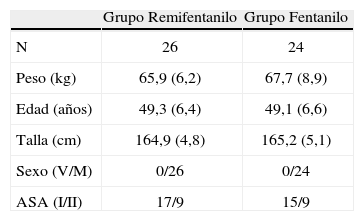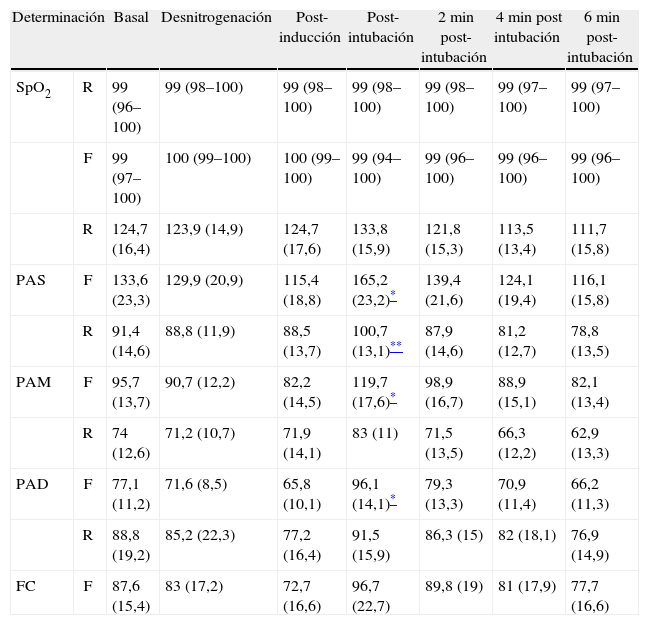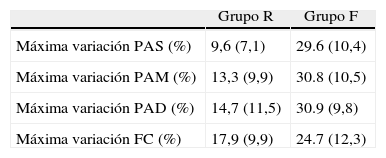Comparar la eficacia y seguridad del fentanilo con remifentanilo en la prevención de la respuesta hemodinámica asociada a la laringoscopia directa e intubación orotraqueal, y su repercusión sobre la saturación periférica de oxígeno en mujeres normotensas programadas para cirugía ginecológica.
Material y métodoEstudio clínico prospectivo en pacientes ASA I-II sometidas a cirugía ginecológica. Se distribuyeron de forma aleatoria en dos grupos: grupo R, remifentanilo 1 μg Kg−1 min−1 hasta la intubación y grupo F, fentanilo 2 μg Kg−1. Para la inducción anestésica utilizamos etomidato (0,3 mg Kg−1) y bromuro de rocuronio (0,6 mg Kg−1). Se realizaron siete mediciones seriadas de la presión arterial sistólica, diastólica y media, frecuencia cardiaca y saturación periférica de oxígeno durante los periodos: control, desnitrogenación, postinducción, postintubación y posteriormente cada dos minutos tres determinaciones consecutivas.
ResultadosSe incluyeron 54 pacientes. El grupo R mostró un efecto estadísticamente significativo de atenuación de la respuesta hemodinámica postintubación tanto en la presión arterial (p = 0,0001), como en la frecuencia cardiaca (p = 0,031) respecto de su valor basal. Sin embargo, con el grupo del fentanilo (grupo F), no se observó dicho efecto protector. No se observaron diferencias en la saturación periférica de oxígeno en ambos grupos durante el estudio.
ConclusionesA las dosis utilizadas, el remifentanilo comparativamente con el fentanilo, ofrece mayor control hemodinámico. No se observaron efectos secundarios en ambos grupos atribuibles a los opiáceos.
To compare the efficacy and safety of fentanyl and remifentanil in the prevention of hemodynamic responses to direct laryngoscopy and orotracheal intubation, and to compare the effects of these techniques on peripheral blood oxyhemoglobin saturation in normotensive women undergoing scheduled gynecologic surgery.
Material and methodsProspective clinical trial in ASA 1–2 patients undergoing gynecologic surgery. The patients were randomized to 2 groups: the remifentanil group received a perfusion of 1 μg·kg−1·min−1 until intubation whereas the fentanyl group received a bolus dose of 2 μg·kg−1. Etomidate (0.3 mg·kg−1) and rocuronium bromide (0.6 mg·kg−1) were used for anesthetic induction. Seven serial measurements of systolic, diastolic, and mean arterial pressure were recorded in addition to heart rate and peripheral blood oxyhemoglobin saturation at the following times: baseline, denitrogenation, postinduction, and 3 more times at consecutive 2-minute intervals.
ResultsFifty-four patients were enrolled. A statistically significant attenuation of the postintubation hemodynamic response was observed in the remifentanil group. The effect was evident on arterial pressure (P=.0001) and heart rate (P=.031) with respect to baseline values. That protective effect was not seen in the fentanyl group. No differences in peripheral blood oxyhemoglobin saturation were observed.
ConclusionsRemifentanil provides greater hemodynamic control than fentanyl at the doses utilized. No adverse effects attributable to these opioids were observed in either group.
Artículo
Comprando el artículo el PDF del mismo podrá ser descargado
Precio 19,34 €
Comprar ahora













